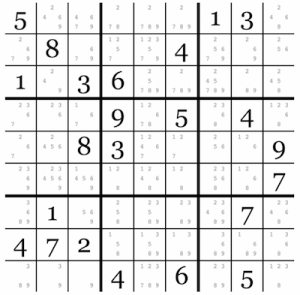I know, I know. I’ve been MIA from this blog. And I feel just terrible about it. I haven’t abandoned it. I always have plenty of projects going on. Lately, I’ve just been wrapped up with a large project that has taken quite a bit of time. Lots of 3D printing and photography and working with new and interesting bits of software. I’m not ready to say much else about it right now.
Lately, though, I’ve had a bit of time to work on other projects. I decided to dig up a half-done Sudoku related project, to give it some polish. The crux of the project is a Sudoku solver (that I intend to write about at some point in the future). I decided that I needed an interface to the solver, so I put together this handy little web interface.
It allows the user to enter an initial puzzle, or to pull a random, pre-made puzzle. After the initial board is set, the user can allow for forbid impossible moves (that is, moves that would conflict with a number that is already set in the same row, column, or block). The user can also show pencil marks. Pencil marks are indications of playable numbers at each position.

I haven’t yet connected to solver to the interface. That’ll come later. The first priority was getting the board to respond to input correctly. Most of the work for managing the available moves on the board is done by my JavaScript class, Board. The Board class takes care of making sure that a move can be made, and updating all affected squares. The function to place a move in a square will only place the move if it is a legal move, or if the initial board has been set and the option to permit impossible moves is allowed. If the move can be placed, all related squares (squares in the same row, column, or block) are updated.
this.place = function(val, r, c) {
var av = this.available[r][c];
var placed = false;
if ((this.setDone && getEl('impossibles_permit').checked) ||
1 == av[val]) {
this.placed[r][c] = val;
this.updateAffectedLocations(r, c);
placed = true;
}
return placed;
}
Higher level functions that interact with the front end operate outside of the class. The callback used when a move is played either tries to place the move if the keypress is between 1 and 9 (ASCII 49-57), or clear the square on backspace or delete (ASCII 8 or 127, respectively). If the move cannot be placed, blink the square that is blocking it.
function setSquare(e) {
var k = (e == null ? event.keyCode : e.which);
if (activesq) {
var r = activesq.getAttribute('row');
var c = activesq.getAttribute('col');
var activepen = getPen(activesq);
var activepencil = getPencil(activesq);
if (48 < k && k < 58) {
var val = String.fromCharCode(k);
if (myBoard.place(val, r, c)) {
activepencil.style.visibility = 'hidden';
activepen.innerHTML = val;
}
else {
var sq = myBoard.findBlocker(val, r, c);
blinkSquare(sq, errcolor);
}
}
else if (8 == k || 127 == k) {
myBoard.unplace(r, c);
activepen.innerHTML = '';
if (getEl('pencil_show').checked) {
activepencil.style.visibility = 'visible';
}
}
}
clearListener();
return false;
}
A little JavaScript, and a little nice styling… That’s about all that’s involved. I’ll get around to hooking up the solver in the next few weeks.

 Home
Home